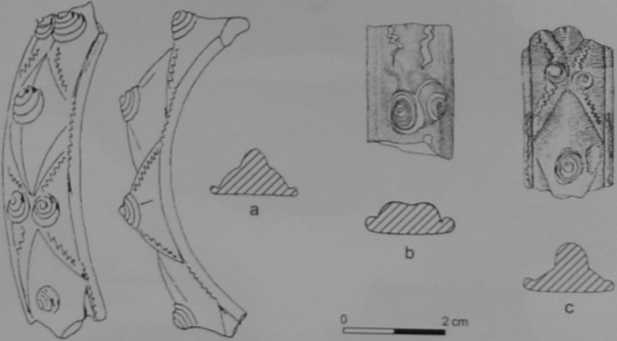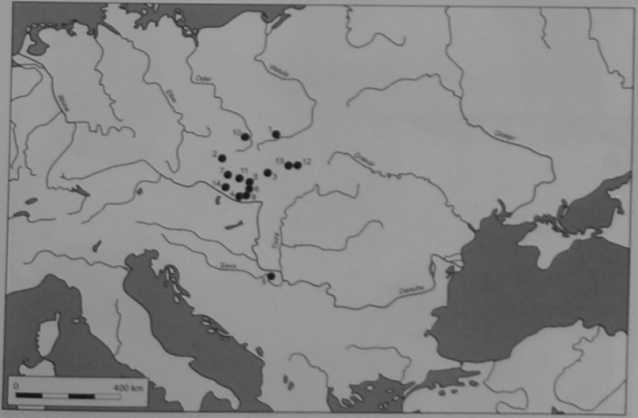42480 S5006664
164
MachJ Karwowski
(Flgs 1. 3a-b). Bracelets of Group 15 aro usuałły fairty massive and mada from characteristic La Tóne translu-cent blue glass. The axtemal surface of these bracelets is inclsed with characteristic elongated lozenges and addltionally decorated with raised bosses. Single bosses ara placed on the lozenges with double bosses between the lozenges. The surface of all the bosses is covered with inset threads of opaque white glass arranged In splrals. Along the incislons of the lozenges, sections of a zigzag linę madę from opaque white or yellow glass ara melted on the surface of the glass.
Bracelets of Group 15 (List 1; Map Fig. 2)' are known from nlne finds from Slovakia (Detva, Holiare, Komjatice, Nitra-Pśrovskó Hśje, Novś Zśmky. Pobedim, PreSov, Spiśskś Podhradie, Zohor), three from Morawa (Bofitov, Mikulfiice), two from Upper Silesia (both from Nowa Cerekwią), one from Western Little Poland (Aleksandrowlce) and two mora from the Scordisd territory of Vojvodina In Serbia (both from Hrtovid-Gomolaua). Moreover, a brace-let of Group 15 which has been preserved in Its entirety though unfbrtunately without details of provenance, was auctioned a few years ago in the Dorotheum, the Vien-nese auctlon house (Fig. 3a). Thus, as research now stands, we have Information on a total of 18 finds of the type of bracelet under discussion1 2 3 4.
Bracelets of Group 15 should be dated to the eariy phase of the Middle La Tinę period. This dating is sup-ported by a find of bracelets of this group in a well-dated grave in Holiare as well as by fragments of bracelets from dwellings in a settlement at Nowa Cerekwią. Speci-mens preserved in their entirety from Komjatice, okr. Nov6 Zśmky and the bracelet from the Dorotheum auc-tion5 certainly oome from skeleton graves, which is un-doubtedly a strong argument In favour of their eariy dating (Vendovś 1980:77; 1990:130; Karwowski 1997:50; Bfezinovś 2002: 25/.
The next characteristic feature for the eaatem pro-vince of La Tśne culture Is the occurrence of glass bracelets with a specific type of decoration, referred to as Schlelfenverzlerung. This decoration is in the form of threads of opaque white or yellow glass usually set Into the glass of the body of the bracelet and arranged Into mora or less regular, long loops. Schlelfenvorzlerung was malnly applied to bracelets of Haevernick’s Group 6b (Haewemick 1960:49-50) (Flgs 3o-d)‘, but Is also known from indhfidual examples of bracelets of other groups. Bracelets decorated In this way are almost exclusively madę of blue glass. The occurrence of bracelets of Group 6b decorated with Schlelfenverzlerung Is dlstinctly con-centrated in the region of the central Danube (List 2; Map Fig. 4). The greatest number (19) of decorated bracelets of this group are known from eastem Austria (Lower Austria: Drósing, Etzersdorf, Góttlesbrunn, Hasel-bach, Herzogenburg, Kleinhóflein, Kleinrust, Michelstet-ten, Roseldorf, Sommerein, Windpassing and one exam-ple with an imprecisely location; Burgenland: lllmitz, Kitlsee, SchOtzen am Gebirge), and only slightly fewer — 15 spedmens — from Slovakia (Bajć-Vlkanovo, Bratislava-Zśhorskś Bystrica, Hurbanovo-Bohatś, Jśnovce-Machalovskś Hradisko, Komjatice, Mafia, Nitra-Chrenova, Nitra-Martinsky Vrch, Nitra-Śindolka, Palśrikovo, Źehra-Spiśsky Hrad, Źitavce). Three bracelets each are known from Hungary (Alattyśn-Tulśt, Keszthely, Ordód-Babót) and Morayia (Bofltov, Mikulćice, Pasohlśvky), two from Silesia, Poland (Roszowicki Las, Ślęża) and one each from eastem Little Poland (Bachórz) and Transcarpathian Ukrainę (Mukachevo-Lovaćka). Bracelets of Group 6b with Schleifenverzierung occur in considerably lower numbers in territories situated further to the west. Twelve such bracelets are known from Bavaria (11 spedmens from oppidum in Manching and one from Sulzbach am Inn), three spedmens from Salzburg Land in Austria (all from DOrrnberg), two each from Switzerland (Belp-Neumattstrasse, Bern-Engehalblnsel) and Thuringia, (JOchsen, Wandersleben), and one from Bohemia (Lib£eves).
It should be emphasised that bracelets of Group 6b are one of the commonest types of glass bracelets in the whole of La Tśne culture, taken within a broad frame-work both chrónologlcally and geographlcally. Spedmens of this group with Schleifenverziervng belong to some of the eariiest dated products of La Tśne glass-working. They are found in cemeteries (e.g. Sulzbach am Inn, Pasohlśvky, Lib£eves, Mafia) together with an inventory dated to the eariiest stage of the Middle La Tśne period
* Vencłovś (1990: 120) dasslfled the bracelets of group 6b wUh Schlelfonverztorung as type 6b/1.

PJJ2TSS °f?cUPI5fr°T ?'^C^m0teVa (a)l Nowa Cw*wrt W and BoMov (c) (after Jovanović. Jovanović 1968: Karwowski 1997 and Souchopovd, Ludikovsky 1972)

p*9- 2. Dlstribution of bracelets of Group 15 (List 1)
1 would Hke to express my gratttude to Prof. Dr M. Parczewski (Rzeszów), Dr G. Bfezinowś (Nitra). R. Naglik (Kraków) for Infoimation concemlng unpubllshed materiał:
* In the literatura, three morę spedmens of bracelets of group 15 are mentioned from Velem In Hungary (Venclovó 1990: 130). Mofeęti In Romanlan Transylwania (Wożniak 1974: 180) and Steinflschbach in Hesse, Germany (Seldel 1994: 582). In all these cases, howawer, the Information Is probably enpneous and In any case does not apply to the bracelets which ara of Interes! to us here (see also Hunyady 1942: 219: Herrmann 1958: 41: Horedt 1965: 69 Ag. 8:9).
* This bracelet. about which thera ara no mora prącise de-tatls. probably oomes from a disturbed or robbed skeleton grawe in Słowakia.
Haevemick (1960:90) dated the bracelets of Group 15 to
the Lete La Tóne period: Gebhard (1989: 55) also dttagreee with the eariler dating of these bracelets.
Wyszukiwarka
Podobne podstrony:
S5006665 Fig. 3. Bracetets of Group 15 from Dorotheum sale (a) and Nowa Cerekwią (b), and bracelets
S5006668 168 KwwowWP Usts List 1. Bfcilm of Group 15 (Map fig. 2): 1. Aleksandrowie©. Poland (unpubl
S5006669 170 Madej Karwowski ĆIMBULEVA Z. 1964; Novoołkrtta elinlstlCaska grobnltsa 61 Ne$eb r. Arkh
S5006667 166 Mactoj Karwowski The remaining face-beads come from territories out-side that of La Tón
S5006669 170 Madej Karwowski ĆIMBULEVA Z. 1964; Novoołkrtta elinlstlCaska grobnltsa 61 Ne$eb r. Arkh
rodzaje koÂci 3a. Bones of dijferent shape. I—long bones (ona langi) (1 A — humerus; 1 B—mctacarpal
164 G. Yim ct ul. Inlcmutionul Joumul of Mcdicul Microbiology 296 (2006) 163 170 his opinion (Waksma
S5006654 JULU EMILOV, Changlng paradlgms: Modern Intarprotatłona of Caltlc ralds In Thrac*
S5006663 The earliest types of eastem-Celtic glass omamentsMaciej Karwowski Artefacts dated to the s
164 Yci ypOKM 3Hr/iii/icbKOi mobu. 5 K/iac (3a niflpyHHMKOM O. Kapn iOK) meopinnsi, swe swe icnye ne
więcej podobnych podstron